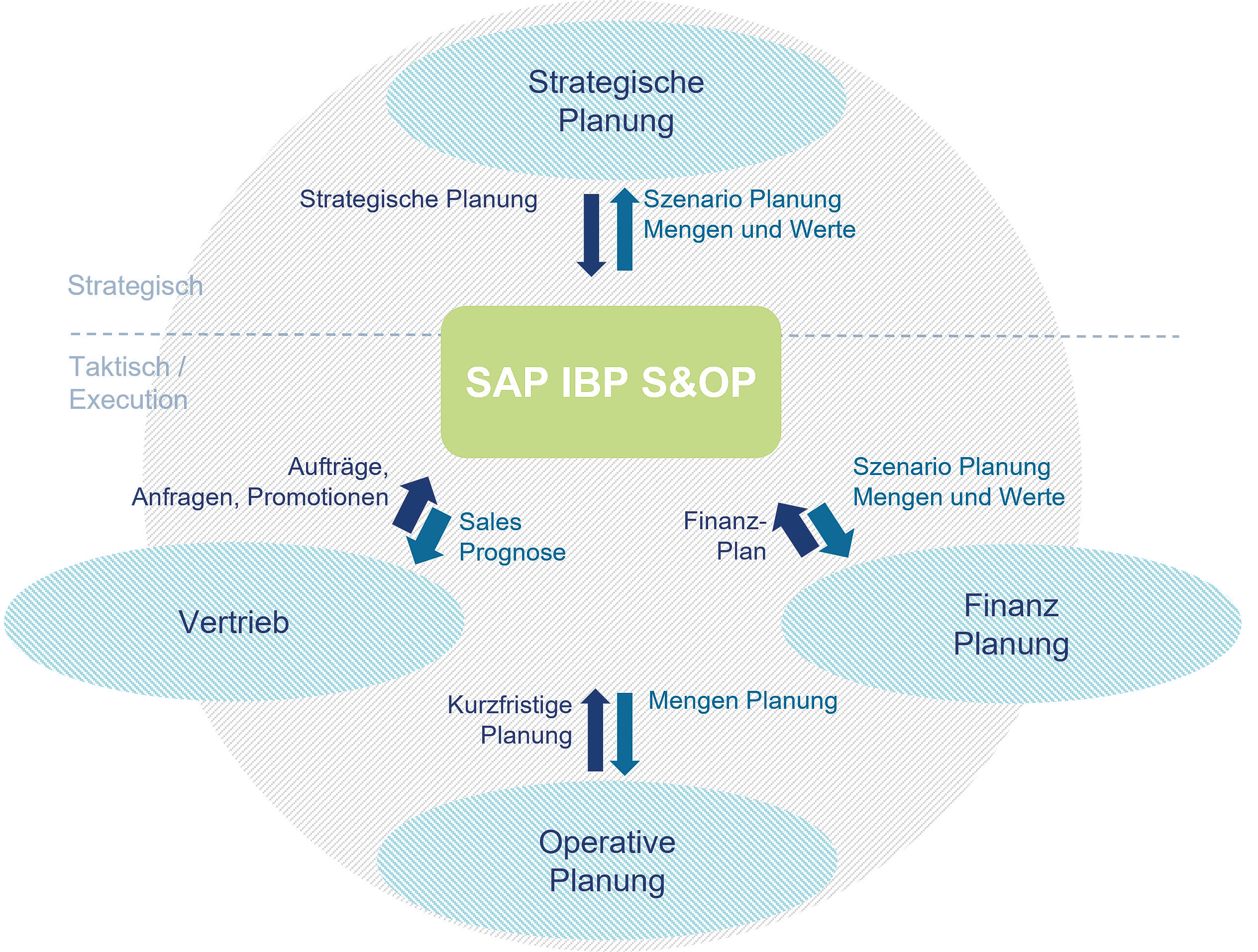The Success Factor Is a Holistic Process Approach


Disruptions in the global supply chain due to trend reversals or market turbulence of a geopolitical, ecological, social or competitive nature are now a daily occurrence. To meet these challenges effectively, users need suitable solutions that offer them end-to-end transparency across the entire supply chain. Although digital tools do not eliminate the hurdles, they do help to realistically assess the risks along the entire value chain, making them transparent and controllable.
This optimal balance between responsiveness and delivery capability, inventories, lead times, sustainability (circular economy) and customer satisfaction enables a proactive response to the volatile market. SAP Integrated Business Planning (IBP) is a powerful solution that helps to overcome these challenges.
But planning is only half the battle in production. The materials must also be in the right place in the right quantity in order to produce economically. This challenge can be met with SAP Extended Warehouse Management (EWM). SAP EWM is a standardized, modular warehouse management/warehouse control system that maps all intralogistics processes. As an important component of the SAP S/4 Digital Supply Chain, SAP EWM can be used in conjunction with other SAP modules to organize and optimize business processes within the entire logistics chain. This means that SAP EWM can also be used to flexibly design complex and high-performance processes in the warehouse and control highly automated logistics systems.
Experienced partners such as CONSILIO always have the entire supply chain in mind when designing and implementing a suitable solution - from planning to production and logistics.

What a planning tool must be able to do
An industrial company can only operate successfully if it has tools that enable IT-supported planning and control processes in all areas and horizons. This starts with long-term strategic planning of the supply chain structure and extends to the product portfolio, sourcing strategies, budgets and investment decisions.
But that's not all: the sales forecasts form the basis for planning for the coming months and years and should therefore be as precise as possible, which can be achieved by using modern algorithms that incorporate historical and current data from marketing, finance, sales or customers. This approach helps to balance conflicting objectives such as service levels and inventory cost reduction and enables the responsible planners to implement a multi-level optimization of safety stocks based on low-error forecasts. The good forecasts and sensible target stock levels then form the basis for optimizing the distribution, production and procurement network.
The SAP supply chain planning solution IBP (Integrated Business Planning) maps all of these functions with system support. However, a successful introduction of this complex planning solution requires a strong consulting partner who has already implemented IBP in various companies and industries and therefore has in-depth expertise in all the planning topics mentioned above.
What makes a good partner
But how do you recognize a suitable partner? In addition to many years of implementation and process consulting experience, they should also be able to offer a tried-and-tested process model. For example, CONSILIO recommends using a mixture of a classic concept phase with workshops, mock-ups and PoCs together with agile implementation in sprints. The early use of fresh production data in tests, training and education is essential in order to involve key users and IT in realistic scenarios from the outset. This approach is often crucial when it comes to identifying and rectifying master data, transaction data and performance problems as well as errors and poor forecasting and planning result quality at an early stage, for example to reduce problems during and after go-live as much as possible.
In addition, good long-term and medium-term supply chain planning should never be viewed in isolation, as it is interlinked with other planning processes and IT solutions whose framework it defines. It is important to consider a holistic concept for supply chain planning and production control with S/4HANA MP&S (ePP/DS) under the keyword "Synchronized Planning", among others. Example: The interaction of supply chain and production planning with the customer order confirmation in ATP or aATP is an essential component of a holistic, successful planning approach.

In a nutshell: the scope and complexity of all these requirements for supply chain planning requires the support of an experienced consulting partner who covers the entire spectrum of necessary business processes and IT solutions, because planning and control must ultimately be implemented with the right logistics processes and IT solutions. One of the most important downstream processes here is efficient warehouse management with an appropriate solution such as SAP EWM.
Thinking from start to finish
Optimal production execution cannot be achieved without efficient warehouse management. The warehouse management system must both ensure the supply of production and be able to react flexibly to short-term changes. SAP addresses these challenges with EWM. The close integration of the solution into S/4HANA and the constant addition of new, innovative functions speak for themselves.
When implementing SAP EWM, the focus is on weighing up which of the available options is the most suitable for your own scenario. In one case, for example, there are good reasons for using delivery-based production integration, while in another case, extended production integration is the best option due to the integration with an MES system. In addition, there are a number of other topics in the area of production integration that need to be defined in the implementation project, ranging from the modelling of a detailed organizational structure to a possible mapping of work in process to consumption postings of materials and goods receipt from production, possibly using synchronous goods movement. Only by taking a holistic view of the process and with the help of CONSILIO's many years of experience in production and intralogistics issues can it be ensured that warehouse management is seamlessly integrated into production execution.
Production is an important area with which warehouse management interacts, but other areas are also relevant in an implementation project, including purchasing, quality management, shipping and transportation management: Purchasing, quality management, shipping or transportation management.
In order to be prepared for all the challenges facing logistics, warehouse processes and their mapping in SAP EWM must be thought through and designed from start to finish - in other words, holistically.
Successful implementation: This is how it works
As SAP WM has been discontinued at the end of 2025 and a necessary switch to SAP S/4HANA is often planned at the same time, many customers are faced with the question of how to switch to SAP EWM. Specialists such as CONSILIO provide support with the migration strategy and the associated choice of the right deployment option (embedded EWM vs. decentralized EWM or public vs. private cloud), for example by identifying and evaluating functional differences.
Even when replacing a third-party solution with SAP EWM, it is important to plan the changeover correctly. When implementing SAP EWM, the SAP Activate approach is generally recommended. CONSILIO has adapted it based on its many years of EWM implementation experience and tailored it to the respective customer situation - "Tailored by CONSILIO". This includes, for example, specially defined best practice processes in the Explore phase, which form the basis for the target process concept.
A key point in the implementation is that the customer is active in the system at a very early stage in order to get to know the new process flows and validate them against the business requirements. In addition to warehouse staff, other people from other areas of the company must also be involved in this validation. As already mentioned, warehouse management is an integral part of process flows in the company and, for example, a person from quality control must familiarize themselves with a new process flow that offers the possibility of making a partial quantity decision as part of a quality check at handling unit level. In addition to the integrative aspect, the use of pragmatic solutions that are adapted to the specific customer situation is important. For example, the storage physics have a decisive influence on the process sequences. A "one-size-fits-all" approach can therefore quickly reach its limits. When designing solutions, CONSILIO therefore follows the approach of utilizing the standard functionalities as far as possible. If no standard functionality is available, the EWM specialists develop customized, innovative solutions that improve the handling of warehouse processes - including hands-free picking using a smartwatch, for example.

The partner's close exchange with SAP is also an advantage, as it allows them to assess whether a requirement can possibly be covered by a planned standard functionality and whether planned development costs can be avoided. In addition, the partner also has the opportunity to incorporate customer requirements into the standard via the Customer Influence Program, as CONSILIO has done, for example, with exact quantity calculation as part of extended production integration with production material requirements.
Theory and practice combined
Designed solutions must work in practice. To ensure that the productive implementation of SAP EWM functions smoothly, the partner must provide support during both the planning and the changeover. It is advantageous if the partner - like CONSILIO - takes a holistic approach, i.e. not only focuses on the technical changeover or the warehouse processes, but also looks at all other issues affected by the changeover with the customer - from the IT strategy and implementation to application support after the go-live. To ensure that the processes are robust, the partner's experts should use stress tests to test the implemented processes live on site in the warehouse. This strategy ensures a successful implementation and the customer can benefit from the advantages of the new solution from day one - after going live.
Conclusion:
Manufacturing in a company is a complex process that is made up of various sub-processes. The planning solution IBP, which also offers a view of the entire supply chain, forms the bracket. Linked downstream processes include detailed planning with MP&S (formerly PP/DS) and intralogistics with EWM. Realistic planning can only be created if all these sub-processes are coordinated and interlinked. To ensure perfect interaction, companies need experienced partners such as CONSILIO for implementation, who take a holistic view of the supply chain. The reason: only with this specific method, coupled with expertise gained from countless projects, can the success of the implementation be guaranteed.






